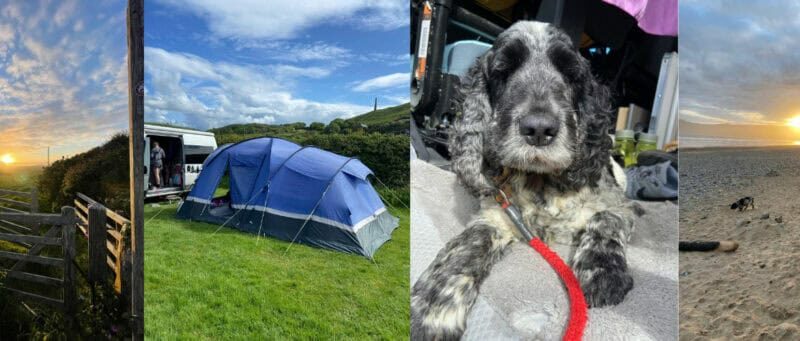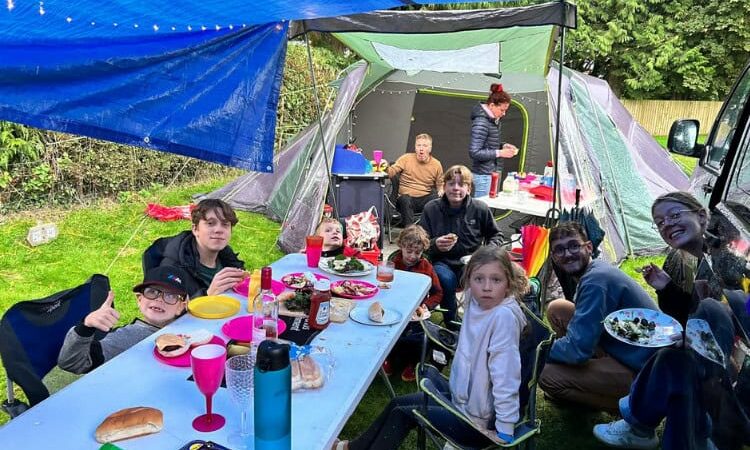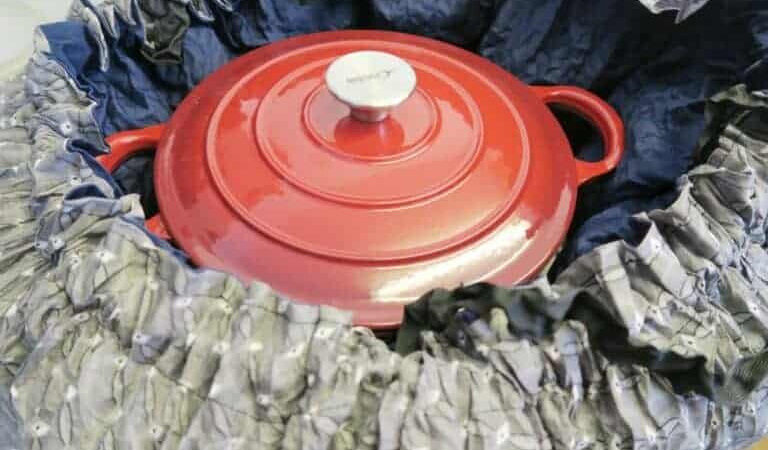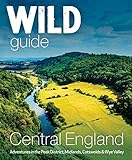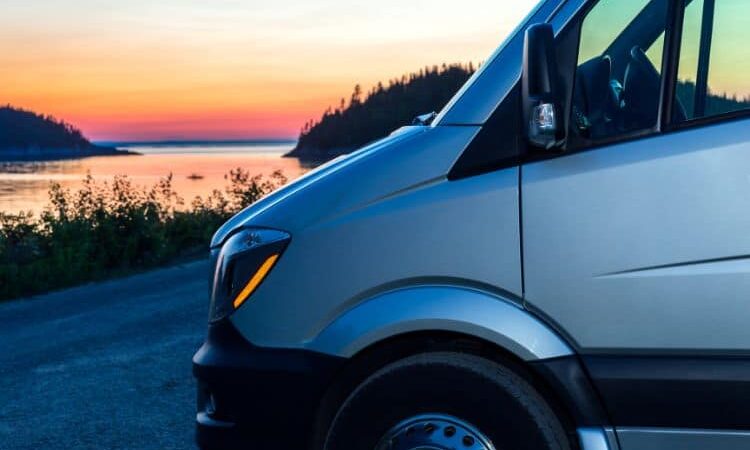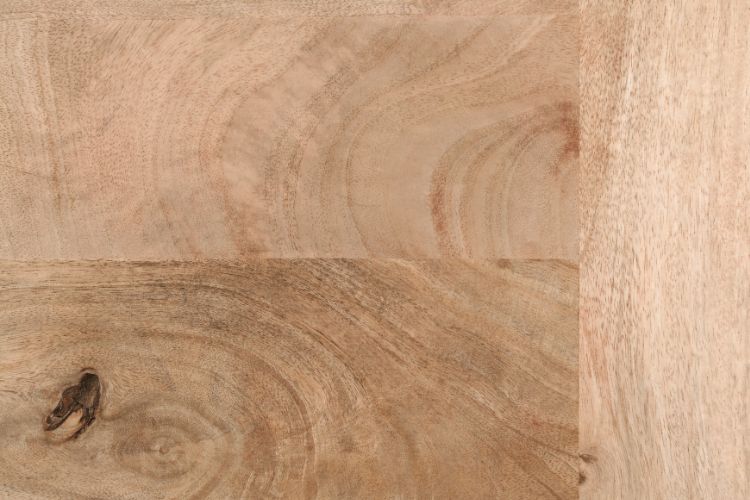Guide To Electric Hook Up – EHU
When you’re camping, you are often looking to get back to nature and enjoy a simpler way of living for a few nights or even a couple of weeks. However, there’s no denying that we all rely on the mod cons available to us and these require power.
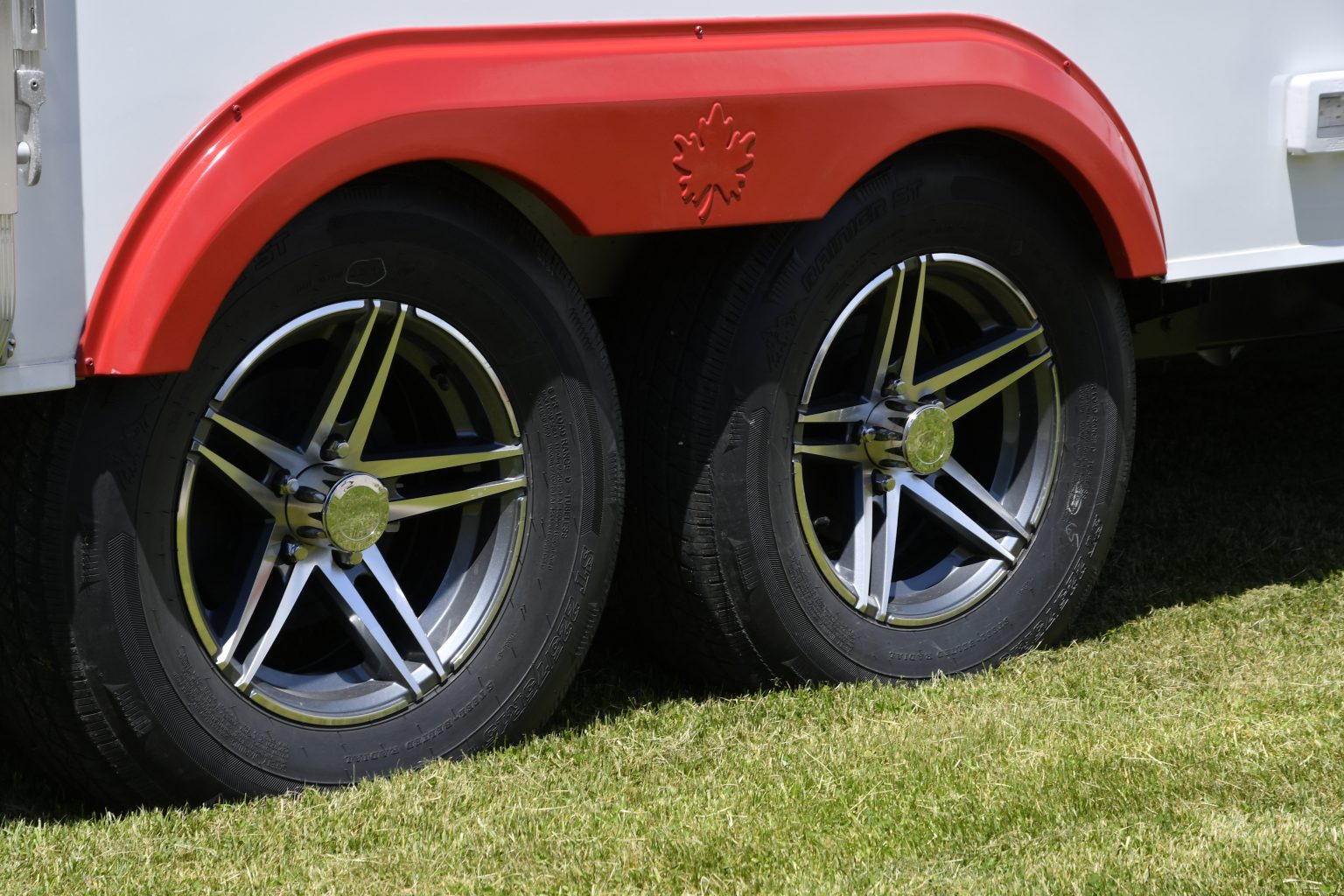
If you’re going camping, it’s possible to have the best of both worlds; you can enjoy spending time in the great outdoors at the same time as charging your smartphone, boiling your kettle, drying your hair and much more. All of this is thanks to an electric hook up.
But it’s important to be aware that not all electric hook ups cables are equal. There are some out there that are less than desirable and could even be dangerous. Moreover, it’s essential to understand what you can and can’t use with your electric hook up and how it all works.
For those new to using this type of equipment, this guide to electric hook ups tells you everything you need to know.
What Is An Electric Hook Up?
Some people are happy to go camping and not use electricity or powered devices at all. They’ll make use of the 12v battery in their motorhome or caravan and live a self sufficient lifestyle for the duration of their trip.
But most of us have gotten so used to the creature comforts of home that we want to be able to take these on the road with us and that’s where electric hook ups become a lifesaver. These hook ups allow you to plug into power and use many appliances in the same way that you would at home.
If you’re going to use electric hook up then you’ll need to make sure that you book a powered pitch on your chosen campsite. You’ll see that these powered pitches have power supply bollards located all around and these are what you’ll use to plug into the power.
Depending on the particular site and the bollards they’re using, you may have between one and four connections. Although there are some more advanced bollards that allow you up to eight connections. Each one of these powers its own pitch. Where your power connection is in relation to your actual pitch will vary by site and the individual pitch. Some may have a bollard on them while others require a longer cable to connect to a bollard a couple of pitches away.
How Much Power Do You Get From An EHU?
Knowing how much power you’ll get from an electric hook up is essential if you want to use it safely. You’ll notice that the current on an EHU is measured in amps, often referred to as simply ‘A’. Generally speaking, a campsite will either provide 10A or 16A for its powered pitches.
However, if you are travelling onto the continent then the current could be a lot lower as a lot of European campsites offer only 5A or 6A.
These figures tell you how much power the bollard puts out. For you, this means that, depending on the amps, you can connect appliances up to this. For example, if you’re on a 10A EHU then you’d be able to use up to 10A at any one time. It’s essential that, when using an electric hook up, you don’t exceed this maximum amount.
It’s also worth remembering that the amount of power being consumed at any one time can vary throughout the day and the time of year. For example, in peak season, there will be more users hooked up to each bollard. The more there are, the harder the bollard has to work and if there are too many appliances connected at once, this could cause an outage.
Plenty of campsites have powered pitches and for the most part, these are safety tested so you can use them with confidence. In order to use the powered pitch, you will need to have an EHU cable. This should be robust and safe but we’ll take a closer look at what to expect from your cable later on.
Once you plug into the powered pitch, you will then be able to connect your appliances and use them as you would anywhere else. That said, there are different types of electric hook up cables and which you use will depend on your requirements. Later on, we’ll explore the different types of EHU cable and what they’re used for so keep reading to find out more.
Using a hook-up cable
To use the site’s electric points, you simply need to attach a cable. The cheapest of these will be a single cable with a connector for the site’s electric point at one end and a connector for your campervan at the other. Easy! Your own decision will be what length to go for – they vary from around 5m to 25m. Prices from start from very little.
This type of cable connection links to your vehicle’s internal electrics so you can use your built-in appliances and power-points.
How Many Watts Can You Use?
We’ve talked about how much power a bollard on a powered pitch might give out but you also need to think about how many watts you can use at a time.
You’ll need to do a bit of simple maths to figure this out, but I promise you, it isn’t complicated. You will need to multiply the voltage by the amps, as follows:
230v x 10A = 2300 watts
But even if you accidentally plug in too much, these hook ups have a circuit breaker which instantly switches off the supply in the event it is overloaded, so you won’t need to worry too much. That said, we certainly aren’t telling you to overload just because you can. Moreover, you have to consider that you’ll be sharing your supply with another pitch. Should you overload and break the circuit then your neighbours will suffer too and that’s hardly a good way to make friends on the campsite!
If you’re camping on a 10A pitch then you will need to check the wattage of your appliances before hooking them up. Let’s use your electric heater as an example. You’ll find the wattage details on the bottom of the heater, in most cases. In this example, we’ll assume that the heater is 2000 watts.
Since a 10A hook up can handle 2300 watts, this heater would be ok to use. However, if you wanted to use anything else at the same time, it’s likely you wouldn’t be able to run the two devices alongside one another. You’d need to switch the heater off while you used your other appliance. The good news is that you can buy camping appliances that specifically have a lower wattage so you’re able to run more at once.
Types Of Equipment
Remember that there are different types of electric hook ups you can buy for camping. Your circumstances and how much power you’d like to use will determine the best option for you.
Hook Up Cable
A hook up cable is the main piece of equipment needed on the campsite. This is what you’ll use to transfer power from the bollard to your tent, caravan or motorhome. If you don’t have this type of cable then you won’t be able to use the power supply at the campsite.
There are different types of hook up cables; those for tents and those for vehicles so make sure that you buy the right type. These are different at one end of the cable but all types will have a male 3 point socket to plug end which you connect to the bollard. If you buy a cable for a tent then this will normally have an end with a single or several plug sockets as well as USB ports. However, for vehicles, the cable will have a female end which you can then plug into the vehicle’s electric point.
Normally, a hook up cable will come in a bright colour. The reason for this is simply to make the cable more visible. In some cases, you’ll have to run the cable through another pitch so these bright colours help to prevent trips.
Mains Hook Up Lead Splitter
On most campsites, you will get a single point for your power supply. However, there may be times that you need to run another power cable and in this case, you will require a mains lead hook up splitter. These come in either 2-way or 3-way designs. They’re able to connect to the power point and will turn a single cable into two or three access points.
You might use one of these if you want to connect power to an awning as well as your motorhome, for example. Another reason that people use a mains hook up lead splitter would be when they use a mobile mains roller unit in addition to the campsite lead.
Mobile Mains Roller Unit
This is a type of secondary power unit that you’ll only really need if you’re going to connect power to an awning as well as your vehicle. It’s great for things like charging your smartphone and other electronic devices as well as for lighting and camping heaters.
These units will typically come with both 3 pin sockets and USB points so they’re pretty versatile. Note that, when you use this type of power unit, it should be used separately from the supply inside your vehicle which means that it is only suitable for use in your awning or tent.
UK Mains Electric Hook Up Adapter
If you are looking to connect your caravan or motorhome to a domestic UK 13A socket then you will need a UK mains EHU adapter. Most of the time, you would use this before you head off on an adventure for testing your equipment. You can also use it for charging your 12V battery.
However, they’re also ideal if you’re staying over at someone’s house as you’ll be able to use appliances within your vehicle without the need to use the leisure battery.
European Mains Lead Adapter
As you probably already know, Europe uses 2-pin plugs as opposed to the 3-pin sockets we use in the UK. So, if you’re headed onto the continent then you’ll need to make sure that you have the right type of cable.
You’ll notice that EHUs across Europe can vary quite dramatically. There are actually some that do have a 3-pin power system so you’ll be able to use your regular UK cables but others have the standard 2-pin European set up. Carrying a European cable is a must as you’ll never know what type of system you’re going to get.
Electric Hook Up Safety
Anything that involves the use of electricity needs to be done safely; that goes without saying. So, if you’re looking to use an EHU then we’d recommend following this safety advice.
It is vital that you do not allow your electric hook up unit to sit on the ground. This is because of the potential contact with water and, as we all know, water and electricity do not mix! Even if the weather is warm and there’s very little dew on the ground in the morning, moisture can seemingly spring out of nowhere so it’s never worth risking it. Not to mention, if your cable is in contact with the ground, this will only serve as a trip hazard.
Where water is concerned, you should also make sure that any sockets and plugs are kept dry. Checking them before use takes seconds and could be the difference between safe use and a disaster. When storing your cables, never wrap them in polythene as this could cause condensation.
When you’re using the cable, you’ll need to make sure that it isn’t folded or coiled. If it is, then there is a risk of it overheating and the result could be an electrical fire. Moreover, you could put yourself at risk if you leave appliances switched on overnight or for long periods when it isn’t necessary. Don’t leave appliances unattending and only have them running when you’re actually using them.
Place your appliances somewhere well ventilated to ensure that they don’t overheat. That said, it’s still a good idea to keep them well away from the tent walls just in case they generate a good amount of heat.
As we discussed earlier, there is a limit to the amount of power you can draw at any one time. If you exceed the max then this will trip the circuit and cause disruption for you and your neighbours. While this isn’t really a safety issue, it’s certainly a best practice and it’s also worth remembering that the site might even charge you to reconnect to power.
Once you have finished using your cables, you’ll need to ensure that you store them correctly. Check the cables before storing to ensure there is no visible damage. If there is, either enlist the help of a professional or discard the cables and purchase a replacement. It’s also worth having the electric system in your vehicle regularly tested to make sure that everything is working safely and as it should.
As we mentioned, you should avoid storing the cable in polythene; the best place to store it is in a bag or on a reel. Just make sure you fully uncoil it before using it again.
Reverse Polarity
Reverse polarity happens if the neutral and live wiring is reversed within the socket. While this isn’t usually an issue on UK campsites, it’s quite common when camping in Europe. If you’re using a vehicle wired for UK use then this can be a safety issue.
In this type of set up, the power travels along the neutral wire instead of the live one. The problem with this is that, while it won’t affect how an appliance runs, it does mean that the power continues flowing even when the appliance is off.
You can buy a polarity tester, which is incredibly affordable and will let you know how the EHU is wired. All you need to do is plug the tester into the van or bollard and the lights will give you all the information you need to know.
If it happens that there is reverse polarity, this doesn’t mean that you can’t use the hook up. It simply means that you’ll need an additional piece of equipment called a polarity reverse adapter. This will reverse the flow of electricity and make the hook up safe to use.
Things To Keep In Mind When Buying An EHU Cable
As with anything, you’ll find that there are some excellent EHU cables out there and some that you wouldn’t want your worst enemy to use. For this reason, you’ll need to understand what to look for when buying an electric hook up cable so that you don’t end up with something dodgy and dangerous.
The cable should have an IP waterproof rating of at latest IP44. Moreover, you’ll need to make sure that the cable is thick and at least 15 metres in length.
There should be a built in residual current device, known as an RCD as well as a clip that enables you to keep the cable lifted off the floor. If it does not have all of these things then we really wouldn’t advise risking using it.
Make sure that you NEVER try to use a regular extension cable when camping. These are not fitted with RCDs and are also not waterproof so not suitable for outdoor use. Trying this could result in an electric shock that has the potential to kill you.
Using Electric Hook Ups
Now that you understand how to safely use an electric hook up, let’s start thinking about the ins and outs of using the system. Correct use will not only give you the best access to power and make it safe but it’ll also ensure that your vehicle doesn’t sustain any damage.
As well as the cable having an RCD, it’s preferable if your vehicle also has one too. This will shut off the power if there is a problem and protect you from getting a nasty shock.
Getting Connected
Once you arrive at your chosen campsite, getting connected to power isn’t a complicated task. Just follow these steps:
-
Make sure that the RCD in your vehicle is off before you start.
-
Take out the mains cable and unravel this so that there are no kinks, coils or folds.
-
Connect this cable to your vehicle.
-
Now connect the other end of the cable to the power supply bollard on your pitch. Note that this may be a couple of pitches down which is why it’s imperative that you have a cable long enough to reach a bollard that’s further away.
-
Go back to the vehicle and switch the RCD on.
-
At this point, you will need to use your reverse polarity tester if you are camping in Europe. Should you need to, you can then connect your polarity reverse adapter in order to safely use the supply.
-
You’re not ready to start connecting appliances and enjoying your trip.
Disconnecting From The EHU
When your holiday is over, you will need to disconnect from the power supply. Again, this needs to be done in a specific way but it’s just as easy.
-
Ensure that the RCD in your vehicle is in the off position.
-
Go to the power supply bollard and disconnect that end of the cable. In some cases, you need to use a release button located on the bollard to be able to take the cable out.
-
Return to your vehicle and disconnect the cable from that end.
-
Make sure that you correctly store your cables because, as we mentioned, not doing so could cause them to become unsafe.
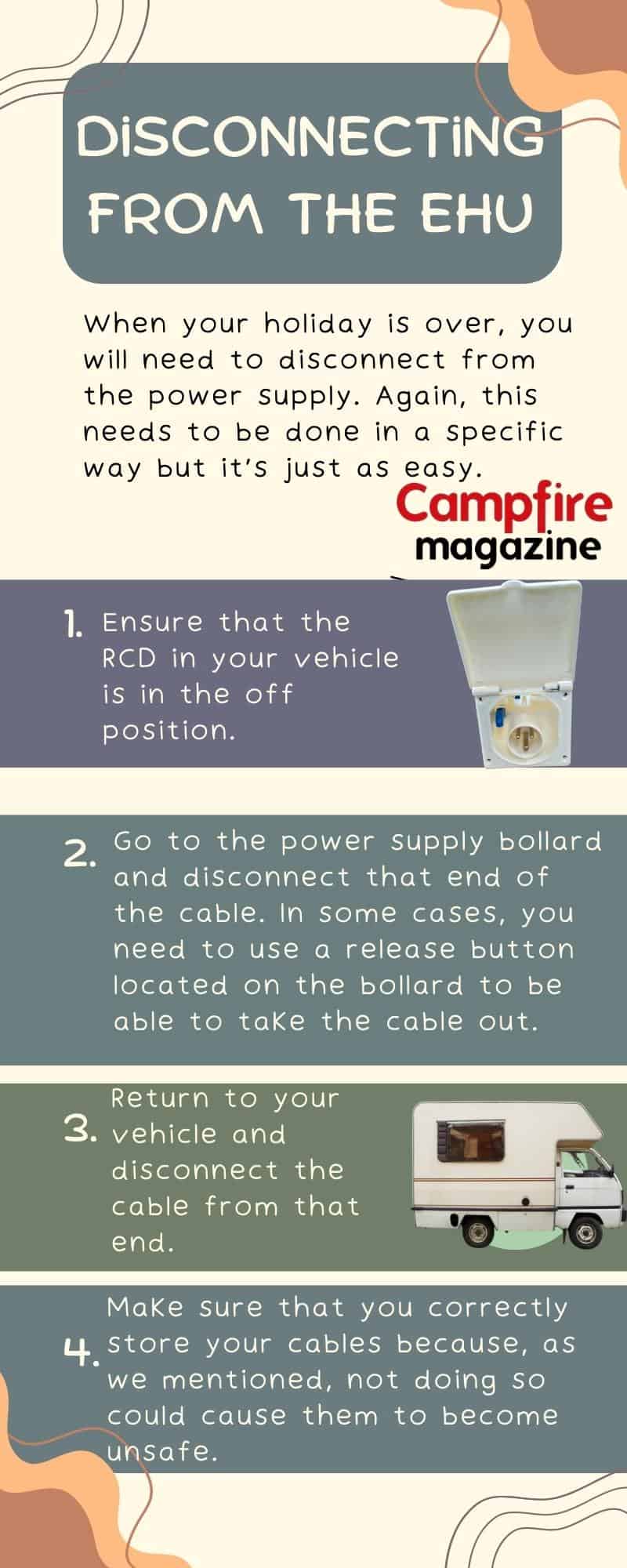
What Type Of Appliances Can You Use With An Electric Hook Up?
Please keep in mind that, when camping and using an electric hook up, you won’t be able to use appliances quite like you do at home. What we mean by this is that you can’t simply plug everything in and just leave it. The power supply won’t be able to handle this and it’ll just cut off.
As we mentioned earlier, you will need to check the voltage of your appliances before using them. For most travel or camping appliances like kettles, heaters, hairdryers and the like, the wattage will be low enough to run them safely.
It’s important to remember that any appliance you use in your tent or camping vehicle will need to be low wattage and not exceed the maximum for that particular EHU.
Power requirements for camping
We spotted this in the shared kitchen of our favourite campsite – Neil and Pat being as helpful as always!

Conclusion
Camping allows us to spend time outdoors and really appreciate nature. A lot of us enjoy the simpler things when on a camping trip but that doesn’t mean that we won’t benefit from electricity.
While your tent might not have power and your vehicle might rely on a 12v battery, a lot of campsites in the UK and abroad have powered pitches. These have power supply bollards that allow you to connect to power and use your essential appliances during your stay.
You will need to purchase an EHU cable and ensure that it has all the right traits for safe use. It’s then simply a case of connecting to your power supply bollard and you’re good to go.
Always ensure the safe use of electric hook ups and never exceed the maximum wattage.
Source: https://campfiremag.co.uk/guide-to-electric-hook-up/


